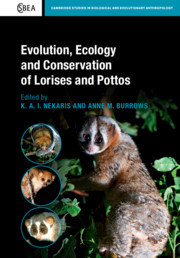Description
Evolution, Ecology and Conservation of Lorises and Pottos
Cambridge Studies in Biological and Evolutionary Anthropology Series
Coordinators: Nekaris K. A. I., Burrows Anne M.
The first book to present the latest discoveries on the behaviour, ecology and evolutionary biology of lorises and pottos.
Language: English
Subject for Evolution, Ecology and Conservation of Lorises and Pottos:
Publication date: 03-2020
510 p. · 17.9x25.2 cm · Hardback
510 p. · 17.9x25.2 cm · Hardback
Description
/li>Contents
/li>Biography
/li>
Furry and wide-eyed, lorises and pottos are small, nocturnal primates inhabiting African, Asian and Southeast Asian tropical and subtropical forests. Their likeable appearance, combined with their unusual adaptations - from a marked reduction of the tail to their mostly slow, deliberate locomotion, powerful grasping and, in some species, a venomous bite - has led to a significant rise in research interest in the family Lorisidae over the last decade. Furthermore, lorises in particular have featured frequently in international media largely due to illegal trade, for example as pets. This is the first volume to present a full picture of the breadth of research being undertaken on lorisids to aid future studies as well as conservation efforts. Focusing on five key topics: evolutionary biology, ecomorphology, behavioural ecology, captive management and conservation, this book is a vital read for graduate students and researchers in primatology, biological anthropology, evolutionary biology, animal behaviour and conservation.
Foreword; Acknowledgements; 1. Introduction: overview of lorises and pottos; Part I. Evolution, Morphology and Fossil Record: 2. Sluggards and drunkards? A history of the discovery and description of the Afro-Asian lorisidae; 3. What we know (and don't know) about the fossil records of lorisids; 4. Outliers: have lorisids moved beyond touch?; 5. Molecular advances in lorisid taxonomy and phylogeny; 6. The toothcomb of Karanisia Clarki: how does exudate-feeding fit into the ecology of this loris-like basal strepsirrhine?; 7. The soft-tissue anatomy of the highly derived hand of perodicticus relative to the more generalised nycticebus; 8. Making scents of olfactory sensitivity in lorises and pottos; 9. Allometric and phylogenetic diversity in lorisiform orbit orientation; 10. The evolution of social organisation in lorisiformes; 11. Biomechanics of loris locomotion; 12. What role did gum-feeding play in the evolution of the lorises?; Part II. Ecology and Captive Management: 13. Nutrition of lorisiformes; 14. Seeing in the dark: visual function and ecology of lorises and pottos; 15. Thermoregulation in lorises; 16. Home range, activity budgets and habitat use in the Bengal slow loris (Nycticebus Bengalensis) in Bangladesh; 17. Behaviour of pottos and angwantibos; 18. Positional behaviour and substrate preference of slow lorises, with a case study of nycticebus Bengalensis; 19. Sexual differences in feeding and foraging of released Philippine slow lorises; 20. Ranging patterns of the pygmy slow loris (Nycticebus Pygmaeus) in a mixed deciduous forest in Eastern Cambodia; 21. Utilising current and historical zoo records to provide insight into the captive biology of rarely kept pottos and angwantibos; 22. Mother-infant behaviours in greater slow loris (nycticebus coucang) dyads consisting of mothers pregnant at confiscation and their sanctuary-born infants; 23. Husbandry and reproductive management recommendations for captive lorises and pottos (nycticebus, loris, and perodicticus); Part III. Research, Trade and Conservation: 24. Trapping, collaring and monitoring the lorisinae of Asia (loris, nycticebus) and perodicticinae (arctocebus, perodicticus) of Africa; 25. Evaluation of field techniques used to assess populations of pottos and lorises; 26. Occupancy modelling as a method to study slender loris density; 27. Using accelerometers to measure nocturnal primate behaviour; 28. Distribution and conservation status of slow lorises in Indo-China; 29. Wildlife trade research methods for lorises and pottos; 30. Online imagery and loris conservation; 31. Slow lorises as photo props on Instagram; 32. Integrating science and puppetry to inspire teenagers in rural Asia to value slow lorises; 33. Developing a rescue and rehabilitation centre as a reaction to the extensive illegal wildlife trade in slow lorises; References; Index.
K. A. I. Nekaris is Professor of Biological Anthropology at Oxford Brookes University, where she directs the Nocturnal Primate Research Group and the M.Sc. Primate Conservation. She has conducted fieldwork on lorisids since 1993, and is Director of the Little Fireface Project, using conservation education, ecology and advocacy to conserve nocturnal mammals.
Anne M. Burrows is Professor of Anatomy at Duquesne University, Pittsburgh. She has been working on evolutionary morphology of lorises and pottos for twenty years, focusing on feeding mechanisms and communication. She is co-editor of The Evolution of Exudativory in Primates (2010) and co-author of Primate Communication: A Multimodal Approach (Cambridge, 2013).
Anne M. Burrows is Professor of Anatomy at Duquesne University, Pittsburgh. She has been working on evolutionary morphology of lorises and pottos for twenty years, focusing on feeding mechanisms and communication. She is co-editor of The Evolution of Exudativory in Primates (2010) and co-author of Primate Communication: A Multimodal Approach (Cambridge, 2013).
© 2024 LAVOISIER S.A.S.
These books may interest you

Indonesian Primates 242.64 €



